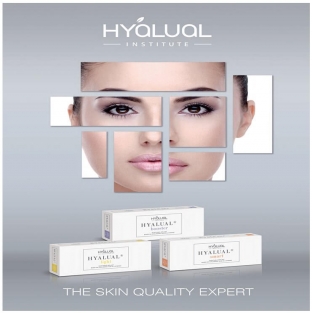Every second patient of a cosmetology clinic turns to doctors with a frequent problem of clearly manifested age-related changes on the face and a great desire to reduce them, slowing down the deepening of signs of extreme old age as much as possible. Modern aesthetic medicine has a significant arsenal of tools and methods to correct the signs of facial skin aging. Read about one of such effective and modern methods, substantiated by personal experience of application by specialists, on estet-portal.com.
 Valentina Zolotareva – Candidate of Medical Sciences, dermatovenereologist of the highest category, cosmetologist, scientific director of the cosmetology department of the Ukrainian Academy of Dermatovenereology.
Valentina Zolotareva – Candidate of Medical Sciences, dermatovenereologist of the highest category, cosmetologist, scientific director of the cosmetology department of the Ukrainian Academy of Dermatovenereology.
What determines the manifestation of signs of aging on the skin
Aging of the body, including the skin – this is a natural process of involution, in which adaptive capabilities decrease and the risk of developing pathological processes increases. The degree of skin aging is referred to as markers that determine the biological age of a person. Age-related changes in the skin are manifested by thinning and dryness, loss of tone and coarsening of the texture. On aging skin, wounds heal slowly, but bruises easily occur and blood vessels appear. Pronounced gravitational ptosis, affecting the soft tissues of the face, accentuates the appearance of wrinkles, creases and folds.
Some manifestations of age-related skin changes and their causes
|
Phenomena |
Substantive process |
How it appears on the face |
|
Metabolic disorder |
- cellular respiration is disturbed; - energy production slows down; - the synthesis of collagen and elastin worsens; - accumulation of HA associated with proteins; - deposition of underoxidized products in cells and extracellular matrix |
- recovery processes worsen; - ionic balance is disturbed; - pH balance changes; - extracellular matrix changes structure and properties; - cell proliferative activity is suppressed |
|
Uncontrolled free radical activity |
- cell membrane lipids are damaged; - the protein structures of the dermis are destroyed; - microcirculation worsens; - nucleic acids are damaged |
- chronic inflammation develops; - functional cellular activity is disturbed; - skin color and texture deteriorates |
|
Impaired hydrobalance |
- the amount of HA that is not associated with proteins decreases; - the ability of HA to bind water and retain it in the skin decreases; - ion exchange is broken; - the content of HA in the epidermis decreases; - changes in the content of various glycoraminoglycans in the dermis |
- skin tone decreases and its turgor worsens; - folds and wrinkles are formed; - thickening of the stratum corneum |
First of all, skin aging is associated with the state of its connective tissue, that is, the dermal layer. Therefore, the main efforts of specialists are aimed at restoring its structure and functional properties.
Cosmetic methods of influencing the state of the dermis and improving its condition, restoring functions are called "redermalization". The impact on the dermal layer during redermalization is carried out with preparations based on high molecular weight hyaluronic acid. This substance has the ability to inactivate free radicals and block proteases. HA metabolites activate fibroblasts, stimulate cell renewal, affect the remodulation of the extracellular matrix.
HA-based preparations are quite effective in the initial signs of age-related skin changes or photodamage, however, in case of pronounced manifestations of skin aging, they may not be enough – a much more pronounced effect and prolonged action will be given by complex preparations that combine high molecular weight hyaluronic acid and sodium succinate. Such complex preparations include Hyalual®.
Due to what properties is the complex preparation Hyalual® effective
The effectiveness of the complex preparation Hyalual®is based on the synergy of high molecular weight hyaluronic acid and salts of succinic acid – sodium succinate.
Hyaluronic acid, in addition to the effect of tissue hydration, when injected intradermally works as an anti-inflammatory agent, a strong antioxidant and immunomodulator. It promotes the elimination of toxins, stimulates the proliferation of fibroblasts.
Succinic acid salts are active metabolites, being a product of the tricarboxylic acid cycle, they combine antioxidant and antihypoxic properties. The peculiarity of succinic acid is that it is found in all our tissues and organs, it belongs to non-toxic natural compounds. Its role in the human body is very multifaceted:
- reduces the negative effects of oxygen deficiency;
- improves the absorption of oxygen circulating in the blood;
- regulates the production of serotonin and histamine;
- improves microcirculation in tissues;
- promotes the restoration of pH balance;
- prevents inflammatory acidosis after intense sun exposure.
Due to sodium succinate, the anti-inflammatory and antioxidant effect of hyaluronic acid is significantly enhanced, skin elasticity is increased, texture is evened out, and color is improved.
Hyalual® with high molecular weight hyaluronic acid and sodium succinate affects almost all etiopathogenetic mechanisms of skin aging.
The drug Hyalual® is intended for intradermal administration, indications for its use are photoaging and age-related changes in the skin of the face and body, stretch marks, scar tissue, Hyalual®; recommended for preparation for invasive procedures and during the rehabilitation period after them. The form of the drug is chosen depending on the severity of the defects and the condition of the skin: for dry skin, Hyalual® is recommended; modifications of 1.8 and 2.2%, for oily skin – option 1.1%.

Hyalual® application techniques; based on personal experience
Depending on the area of cosmetic correction, the severity of age-related changes and the effect you want to achieve, you can vary the injection technique, taking into account the modification of the drug:
- Hyalual® 1.1% – linear, short-line, multi-puncture technique (without papules);
- Hyalual® 1.8% – technique linear, short-line, multipuncture (without papules), reinforcement;
- Hyalual® 2.2% – linear technique introduction, reinforcement.
When correcting involutional changes in the skin in patients older than 45 years, it is better to use a linear technique and reinforcement, while multi-puncture and short-line techniques remain for the correction of small areas. The drug is injected into the middle layer of the dermis with the most metabolically active fibroblasts. The injection is carried out along the Langer lines, which correspond to the orientation of the collagen fibers, and in the direction perpendicular to the wrinkles.
Hyalual® 1.8% and 2.2%, this technique is needed in the correction of clinical manifestations of gravitational ptosis. In this case, it is necessary to treat not only the problem area itself, but also a part of the skin under its lower border in order to provide support from the thickening tissues.
To correct age-related changes in the periorbital region, the Hyalual® form is preferred; 1.8%. Injections are carried out in a linear or short-line technique perpendicular to the palpebromalar furrow. The injection lines should have directions conditionally converging to the pupil beyond the boundary of the bony edge of the orbit in order to achieve the maximum effect of skin lifting. In the area of \u200b\u200b"crow's feet" reinforcement can be applied.
Redermalization usually includes 5 treatments – once every 2 weeks, then maintenance sessions once a month are recommended. Patients notice an improvement in texture and the absence of skin dryness already after the 1st session, after the third session, the skin relief is usually smoothed out, and after the 5th session, patients observe a distinct lifting effect.
The data of clinical and instrumental studies indicate that after a course of redermalization, positive changes in the structure and functional properties of the dermal layer are observed, causing a significant decrease in the signs of skin aging.







Add a comment